NOTE: This article is sponsored by iRise
NOTE: For the latest details on iRise and Prototyping see:
iRise: Why Prototyping is Essential In the Post-Information Age
Executive Summary
Business analysts are on the front lines of mission-critical projects, eliciting and distilling thousands of requirements from multiple stakeholders into concise specifications for complex applications. Getting the business requirements right is critical, but companies often trip up during this critical first step.
|
Sponsored by:
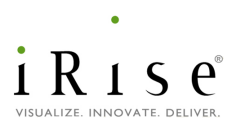
|
The reason is simple. The tools available to business analysts haven’t changed in over 30 years! Text documents, spreadsheets, flow diagrams, and static screenshots are nearly impossible for business people to understand and interpret. The communication breakdown between business and IT hits business analysts hard. Extra work and long hours are the norm when you’re trying to get business and IT on the same page.
The bottom line is that business people really don’t know what they want until they see and interact with it. Months can be wasted trying to gain consensus on what to build using traditional requirements methods.
Now there’s a better way.
|
“When we delivered a major new project on time we experienced something that had never happened before; there was zero rework!”
Ellen Baker
Business Analyst
Asurion
|
Thousands of business analysts have turned to software visualization from iRise as a strategy to simplify their jobs and cut through the confusion. With iRise, business analysts are empowered to quickly assemble a high-fidelity working preview of an application before development ever begins. These visualizations look and act just like the final product, creating an accurate visual model for what to build. All types of applications can be visualized with iRise, which is easy to learn. Business analysts get faster results and produce better specifications, leading to projects that succeed. No more long hours of overtime scrambling to elicit and document requirements with old methods. Visualization gives business analysts the tools to take a pivotal role in helping business and IT collaborate with confidence. Armed with visualization, BAs become heroes and the get the recognition they deserve.
The Problem
Delivering business applications to market faster with lower cost and better customer experience are common goals across many companies. Yet these goals have proven elusive due to the simple fact that business people fundamentally have a hard time understanding text specifications, static screen shots, use cases and complex business flow diagrams.
Stakeholder review meetings can be painful as business people try to interpret huge text specifications. Updating documents can take weeks and scheduling key stakeholders for follow-on meetings adds even more time.
It’s common for business people to sign off on specification documents without serious review. You may even hear them say, “I’ll know it when I see it,” which guarantees that, months later, after the developers deliver the application, you will also hear them say, “That’s not what I wanted at all.” The communication breakdown means business analysts spend long hours on requirements, routinely staying late at the office as they try to bridge the divide between business and IT.
The problem is that the tools business analysts have to distill thousands of requirements into concise specifications are outdated. Text documents and spreadsheets don’t cut it. The truth of the matter is that business people need to see and interact with an application before they can truly articulate their needs.
|
“At an annual meeting we presented a visualization of a new broker portal in front of hundreds of agents and were shocked when we received a standing ovation.”
Alicia Djuricic
Northwestern Mutual Life Insurance
|
Other industries that faced similar challenges transformed themselves by moving from drafting boards to Computer-Aided Design (CAD) and 3D modeling tools to get products defined and delivered in half the time. These tools are now a competitive necessity when designing cars, airplanes, bridges, semiconductors and buildings.
So why do we continue to define business software with the equivalent of outdated drafting boards?
Fortunately, there’s a way for business analysts to get their jobs done quicker, easier, and more effectively. The answer is software visualization.
Introducing iRise
iRise empowers business analysts to quickly assemble working visualizations of business software – often in a matter of hours. Visualizations are working previews that are virtually indistinguishable from the final product, including look, feel, data interactions and business logic. Both business and downstream stakeholders get a chance to “test drive” applications before development, speeding the approval and review process. A high-fidelity stakeholder experience gets everyone on the same page - fast. There are no surprises, no long overtime hours trying to catch up, and no missed deadlines.
When business analysts use visualization to elicit and document requirements, four light bulbs turn on for the business:
-
The business analyst becomes a powerful weapon to get to the right answer. The business no longer has to depend on developers to build complicated prototypes that take weeks to code and often turn out to be crude wireframes.
-
Visualizations are assembled at light speed. Stakeholders are amazed when BAs can visualize screens, behavior, data interactions and business logic in minutes. Oftentimes this happens in the middle of stakeholder review sessions, which dramatically speeds up requirements iterations.
-
Stakeholders get a fully immersive, accurate experience when interacting with visualizations. For the first time, the business can ‘test drive’ a simulation of the final system – before any coding. The business analyst gets the ‘real’ requirements faster and easier. And missing requirements become a rarity.
-
Communication is transformed. Business stakeholders lean forward in meetings. They are engaged and participate actively. Communication is facilitated in new and powerful ways. Leveraging visualization, the business analyst becomes a master facilitator and a black belt at getting to the right answer faster.
Business analysts now have a powerful weapon to:
-
Accelerate requirements definition by at least 50%
-
Eliminate long hours of overtime struggling with mountains of documents
-
Gain control over the definition process
-
Ensure that all the business needs are captured
-
Get the recognition they deserve
How iRise Works
The process of assembling an iRise visualization is easy and fast – there’s no coding involved, just a simple drag and drop paradigm.
Scenarios
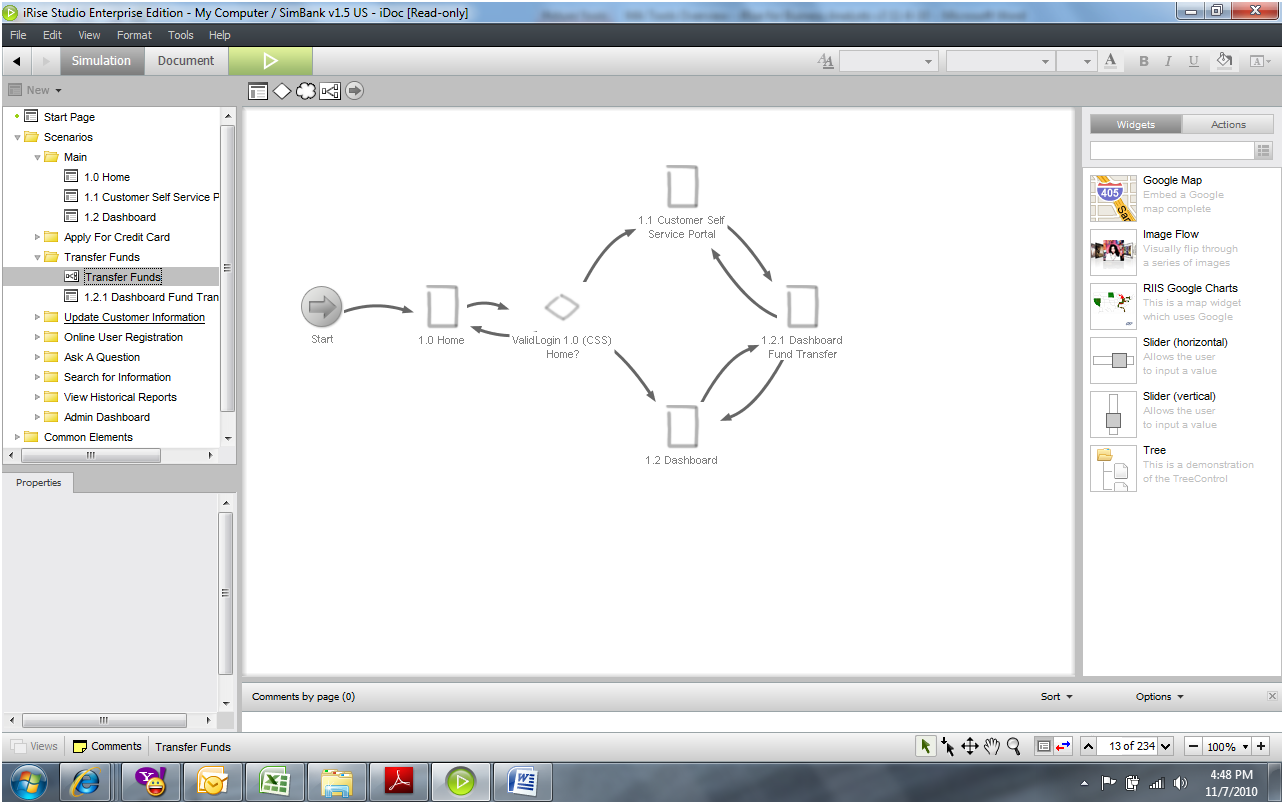
The first step is to map out the flow of the application using scenarios. Pages are dragged onto the scenario whiteboard and linked together to show conceptual flows that are easy for stakeholders to understand. Application elements that aren’t easily visualized like backend processes can be represented easily with clouds.
Rich Interaction

Once the basic flow is determined, full functionality of the application is simulated by dragging text boxes, images and other widgets onto a page from a palette of pre-defined objects provided with iRise. Rich Web-based behaviors can be easily visualized in seconds, including roll-overs, drag and drop, on mouse click and similar actions. iRise iBlocs™ are also freely available from a marketplace hosted on www.iRise.com that make simulating complex behaviors simple, easy and fast.
Business analysts can easily include multiple foreign languages into their visualizations for global application projects.
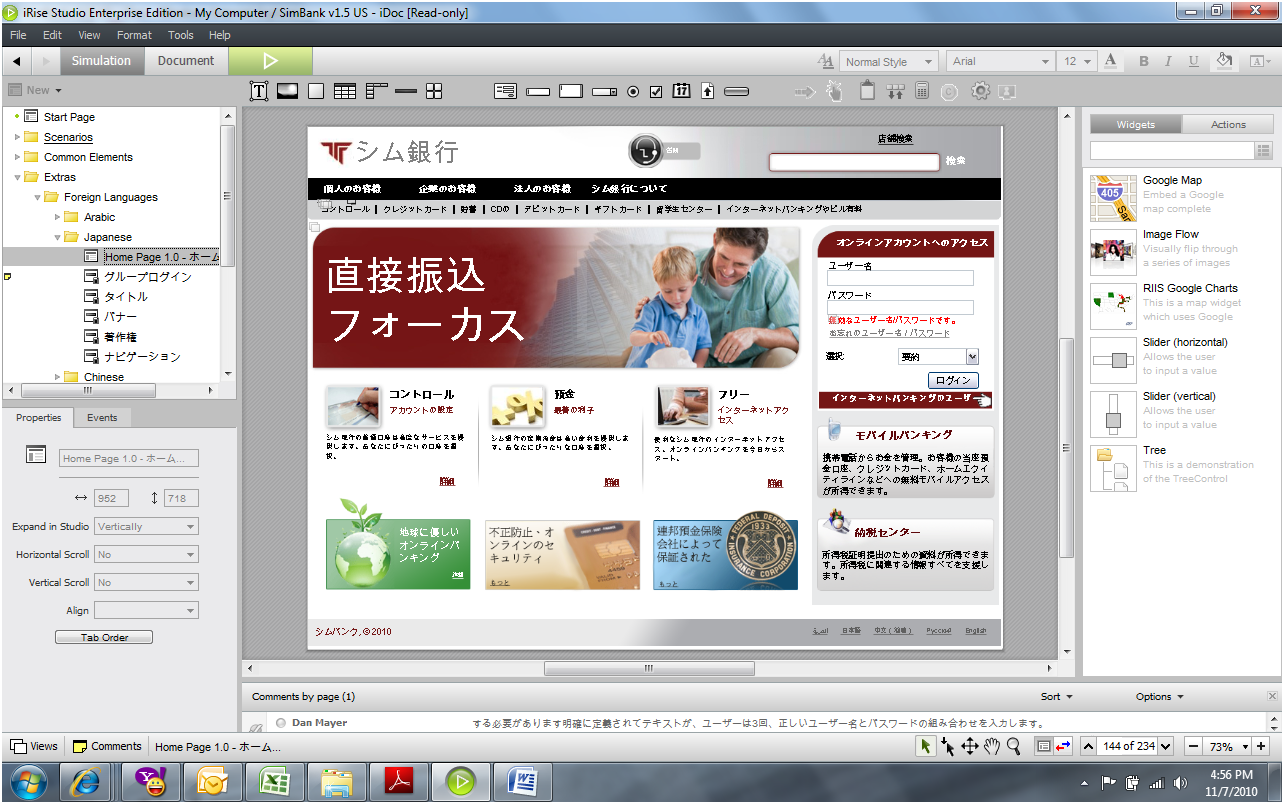
Even mobile apps can be simulated quickly by leveraging a library of pre-defined visualization templates available from the iRise website.
Rich interaction is the key to engaging stakeholders and gathering valuable feedback. A fully immersive, high fidelity stakeholder experience will drive meaningful feedback and get everyone on the same page.
Text Requirements
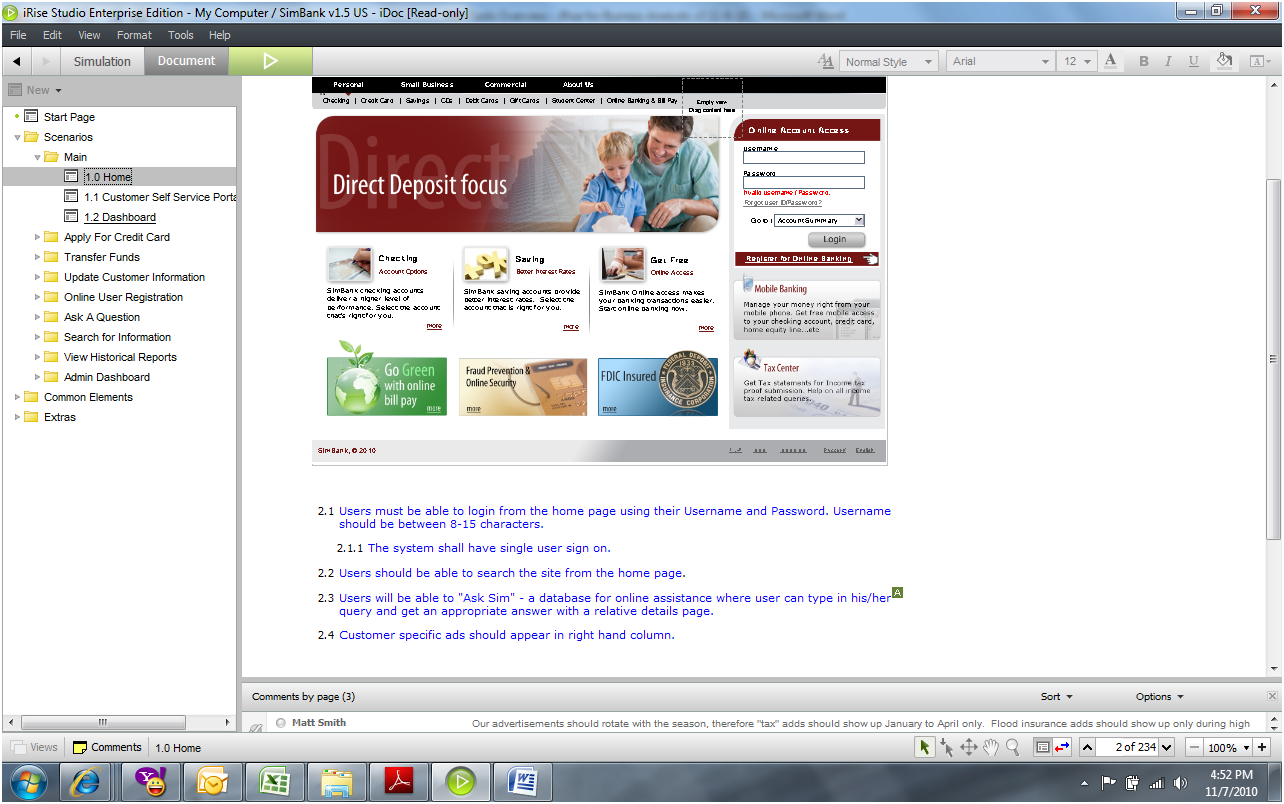
Text requirements can be documented right alongside the screens of the visualization or scenarios. Specific requirements can be visually associated with elements on a page for quick understanding by stakeholders
Data Interactions
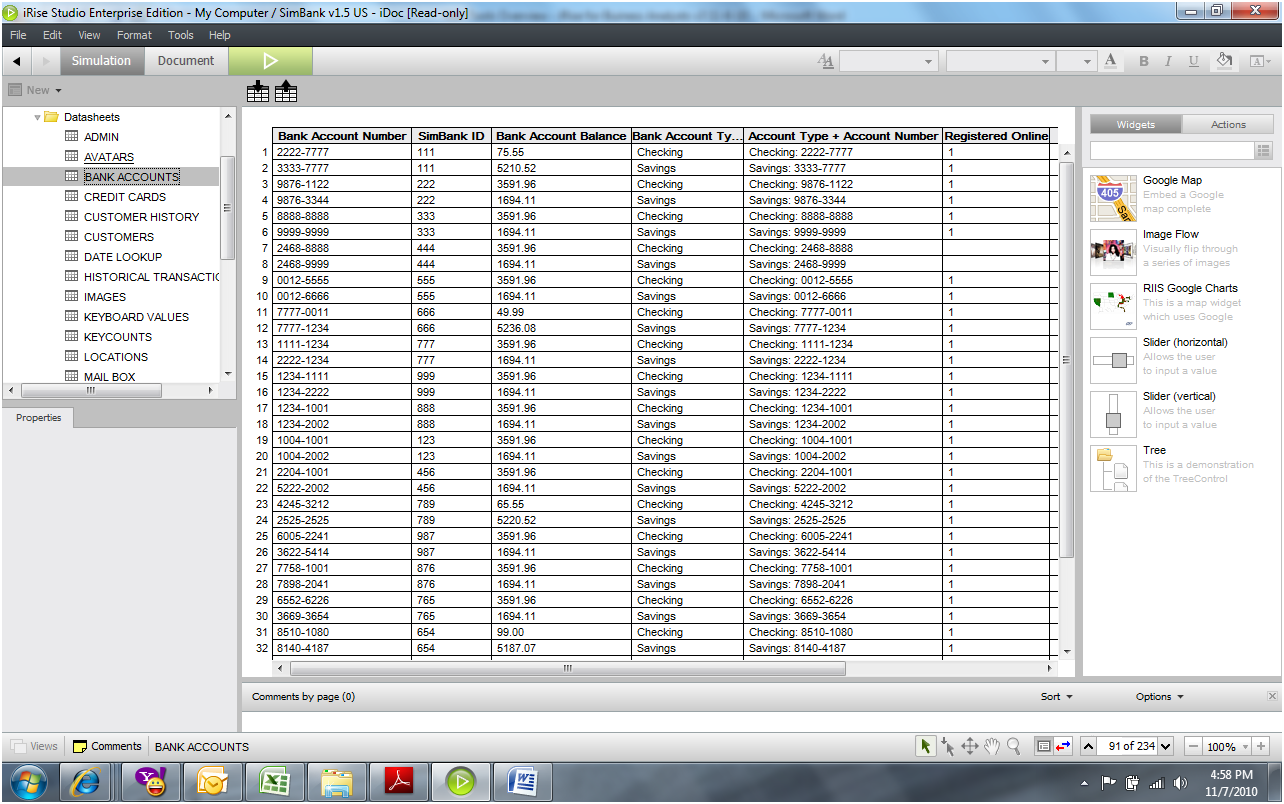
Datasheets enable business analysts to quickly connect real data into visualizations. Datasheets behave much like modern spreadsheets so they are easy to understand. In fact, you can import .csv files to get started quickly. Datasheets can contain text, images and other multimedia objects that make assembling rich simulations a snap.
Masters and Templates
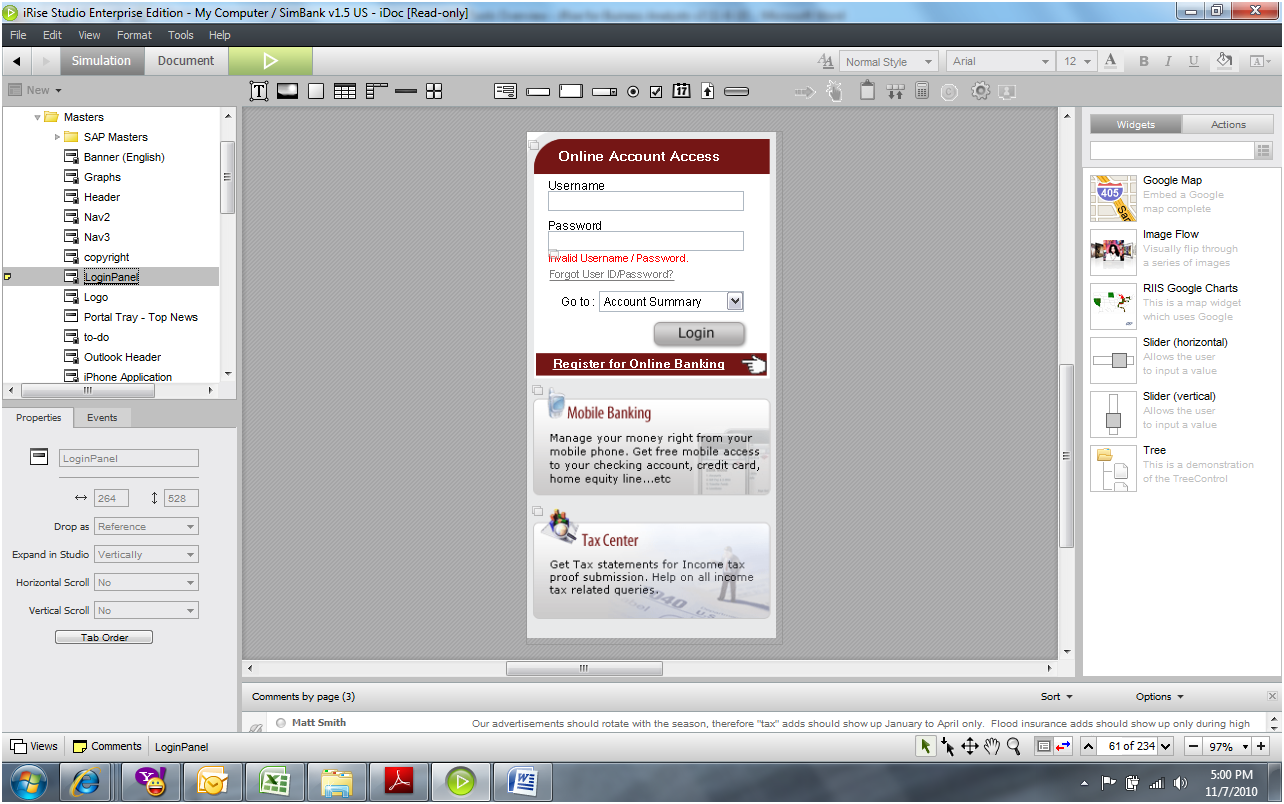
iRise supports the concept of reusable definition assets through the use of masters, which can be dragged and dropped onto a page. Creating a library of reusable pages and components empowers organizations to speed up definition of new projects, enforce branding guidelines, and implement a set of customer experience best practices that drive adoption within the organization. Page templates can also be used to accelerate the creation of pages with common layout and content.
Stakeholder Review

Working visualizations are reviewed in standard Web browsers. This can be done live in review meetings are by sending stakeholders a URL, directly connecting them to the iRise Definition Center, the hub for collaboration. Reviewers are walked through the review process by guides created by the simulation author and they are able to leave comments directly on the screens they are reviewing. Comments are collected and managed by the server for easy access by analysts.
Visualizations also can be published in a self-contained, password-protected file called an iDoc and emailed to stakeholders for review. The free iRise Reader is available from the iRise website and is used to review the iDoc in an offline model. With iDocs, offline stakeholders have the same experience with the visualization as those connected to the Definition Center. Once the annotated iDoc is sent back to the authors, all the comments are collected together for easy review.
Enterprise Collaboration
The iRise Definition Center enables enterprise collaboration in real time, not only during the requirements phase of a project but also during development. Capabilities provided with the iRise Definition Center include:
-
Real-time, team-based collaboration for rapid authoring and iterative review.
-
Self-guided stakeholder guides allow business stakeholders to review and comment on simulations stored in a central server.
-
Reusable definition assets are stored on the server, speeding time to visualization and enforcing customer experience best practices.
-
Powerful comment management collects and organizes stakeholder feedback into easily manageable groups for visualization authors -- a necessity for globally dispersed stakeholder audiences.
-
iConnect™ API jumpstarts downstream development by enabling visualization projects to be exported into XML format. This XML output can easily be converted -- programmatically or using tools -- into richly-formatted specification documents and spreadsheets, integrated into downstream development or quality tools, or even transformed into development assets such as HTML or code.
-
iRise visualizations can be exported into self-contained files called iDocs and shared over email, enabling unparalleled distributed stakeholder feedback, which is captured and collected in a convenient form on the server for definition teams.
-
Reusable iRise content modules can be created, license protected and distributed. The iRise Definition Center supports the distribution of third-party pre-packaged and licensed visualization content. The intellectual property contained within visualizations is protected and licensed to a specific Definition Center and can only be modified by a set of authorized iRise Studio users.
-
Facilitated or self-guided usability tests are possible with a centralized server that captures multiple stakeholder feedback at the same time.
-
Check-in/Check-out for disconnected authoring lets modeling and prototyping activity to continue without pause without network connections.
-
Secure access to critical intellectual property through user authentication is supported for "enterprise grade" organizations.
-
Integrations with IBM Rational Requisite Pro and Requirements Composer.
-
Centralized administration of users, groups, projects through an intuitive administrative user interface.
The Results
With visualization, hundreds of companies and tens of thousands of business analysts now visualize before they build and report dramatic results. Business software gets to market twice as fast with 30 percent less cost. The business analyst has the pivotal role, enabling business and IT to collaborate successfully.
Success story 1:
|
“iRise was instrumental in giving us the ability to quickly iterate the new EMR applications with doctors and nurses in a way that maximized everyone’s time and productivity.”
Sherry Preston
Business Analyst Leader
M.D. Anderson Cancer Center
|
The M.D. Anderson Cancer Center is a leader in the fight to eradicate cancer. With its unique teaching, research and clinical environment, it must invest in a custom electronic medical record (EMR) system. Static specifications were just not effective with clinicians, who could only afford short bursts of time to review and give feedback on proposed systems. Using iRise to quickly visualize an order entry application, former nurses now trained as business analysts involved clinicians in quick, iterative review sessions that lasted no more than 10 minutes. Together, they were able to roll out the new application, training and documentation to hundreds of users is half the expected time, with no rework.
Success story 2:
For an application development team, the biggest challenge is eliciting the correct requirements at the beginning of a project, according to Guy Hamblen, project manager with the Advanced Technology Group at UPS. Ambiguity in the requirements process can lead to substantial delays. But UPS, a nearly $15 billion company that delivers 15.6 million packages a day, has transformed its application development process by adopting visualization as a standard across all lines of business and hundreds of business analysts. As Hamblen tells it, the results have been dramatic: At one stakeholder meeting, a business analyst sitting in the back of the room built a simulation as he listened to the discussion. At the end of the two-hour meeting he stood up and showed the visualization. “I think this is what I heard you talking about,” he announced to a stunned room of high-level line UPS managers. “They didn’t believe what they saw,” Hamblen says. “In that two-hour period of time, he created exactly what they were asking for.”
Success story 3:
The global wealth organization at Merrill Lynch needed a new application system to streamline their account opening processes. Using iRise, stakeholders and developers quickly came to an understanding of the requirements and outcomes, enabling the project to proceed ahead of schedule. The development life cycle of the new account system was cut in half to 45 weeks, finishing nine months earlier than comparable projects using older requirements methods. The accelerated time to market reduced development costs by millions and is now saving 50,000 person-hours of wealth manager and associate time annually.
Summary
The pressure is on to deliver innovative new business software that will drive new revenue opportunities. Business analysts are squarely on the front lines of this growing demand. Designing and building business software with 30 year old technology simply doesn’t make sense anymore. Visualization is quickly becoming the new standard for how the smartest business analysts engage stakeholders and ensure everyone is on the same page. These leading BAs are now fully empowered to become black belts at software definition and are well recognized by their peers for dramatically accelerating better communication with the business.
|
“When we launched the new global account opening application in half the time we committed, I literally had branch office employees come up and hug me!”
COO
Global Wealth
Merrill Lynch
|
Additional Resources
 Author: Mitch Bishop is in charge of overall marketing strategy and execution at iRise. In this role he has built strong relationships with the CIO, analyst and press communities. With his leadership, iRise has grown its customer base more than tenfold and become the market leader in a new industry category: application visualization. Mr. Bishop has many years of marketing and sales experience building successful enterprise software businesses at Scopus, Sybase, Wind River Systems and Ingres. He also held senior engineering positions at Altos Computer Systems, Zilog and Amdahl at the beginning of his career. Mr. Bishop holds a B.S. in Computer Science from the University of Connecticut. He also has a long history in motor sports and sits on the governing council of the non-profit International Motor Racing Research Center (IMRRC) based in Watkins Glen, NY.
Author: Mitch Bishop is in charge of overall marketing strategy and execution at iRise. In this role he has built strong relationships with the CIO, analyst and press communities. With his leadership, iRise has grown its customer base more than tenfold and become the market leader in a new industry category: application visualization. Mr. Bishop has many years of marketing and sales experience building successful enterprise software businesses at Scopus, Sybase, Wind River Systems and Ingres. He also held senior engineering positions at Altos Computer Systems, Zilog and Amdahl at the beginning of his career. Mr. Bishop holds a B.S. in Computer Science from the University of Connecticut. He also has a long history in motor sports and sits on the governing council of the non-profit International Motor Racing Research Center (IMRRC) based in Watkins Glen, NY.